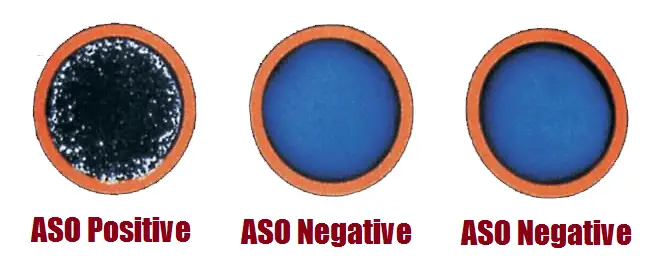What is Anti-Streptolysin O (ASO)?
Anti-Streptolysin O (ASO or ASLO) is the antibody made against streptolysin O, an immunogenic, oxygen-labile hemolytic toxin produced by most strains of group A and many strains of groups C and G streptococci.
In the course of streptococcal infections, the extracellular products of the bacteria act as antigens to which the body responds by producing specific antibodies. Streptolysin O (SLO) is one of two hemolysins (the other being Streptolysin S) produced by virtually all strains of Streptococcus pyogenes.
The letter “O” indicates that this toxin is oxygen labile. The SLO toxin has direct toxic effects on heart tissue. In the course of a streptococcal infection, SLO stimulates the production of specific antistreptolysin (ASO) antibodies, which in-vitro, neutralize the hemolytic properties of the antigen.
Clinical Significance of ASO Test
An antistreptolysin titer greater than 166 Todd units (or >200 IU) is considered a positive test in adults, while The normal value for adults is less than 166 Todd units, which indicates a negative test. Measurement of ASO antibody titre is important in the investigation of post-streptococcal diseases, particularly acute poststreptococcal glomerulonephritis and rheumatic fever.
- Over 80% of patients with acute rheumatic fever and 95% of patients with acute glomerulonephritis have elevated titers of ASO.
- The antibodies level starts to rise in 1-3 weeks after streptococcal infection, peaks in 3-5 weeks, and then goes back to insignificant level over 6-12 months, so a positive test can indicate current but more recent group A, C, and G streptococcal infection.
Tests for ASO
ASO test is done by serological methods like latex agglutination or slide agglutination. ELISA may be performed to detect the exact titre value. The test principle, procedure and interpretation presented here are based on Latex Anti-Streptolysin O (ASO) test.
Principle of the Test
ASO latex agglutination is the rapid and simple test for the qualitative and semi-quantitative measurement of antibodies to Antistreptolysin-O in human serum. This method is based on an immunological reaction between streptococcal exoenzymes bound to biologically inert latex particles and streptococcal antibodies in the test sample. The reagent has been adjusted in the way that presence of an ASO titer of 200 IU/mL or higher in the serum gives a visible agglutination of the latex particles.
Qualitative Test (Screening)
Procedure:
- Bring all reagents and specimens to room temperature.
- Place one drop (50 µl) of the positive control and 50 µl of the patient serum into separate circles on the glass slide.
- Shake the ASO latex reagent gently and add one drop (45 µl) on each circle next to the sample to be tested and control.
- Mix well using disposable stirrer spreading the mixture over the whole test area and tilt the slide gently. Agitate for about 2 minutes with rotator or by hand and observe for the presence or abscence of agglutination.
Results and Interpretation:

- Negative result:
No agglutination of the latex particles suspension within two minutes. - Positive result:
An agglutination of the latex particles suspension will occur within two minutes, indicating an ASO level of more than 200 IU/ml.
Semi-Quantitative Test
Procedure:
- Serum to be titrated is serially diluted (1:2, 1:4, 1:8 etc) in 0.9 g/L saline solution.
- Place one drop of positive control on slide. Do not attempt to dilute the ASO positive control serum for comparative or other purposes as no correlation exists between actual titre of the control and titre of unknown sera.
- Place 50 ml of each serum dilution individually in successive circles on the slide and proceed as in screening methodology.
Results and Interpretation:
The serum ASO titre can be defined as the highest dilution showing a positive result. The approximate ASO level (IU/ml) present in the sample can be optained by the following formula:
- ASO Titre (IU/ml) = Highest dilution with positive reaction x Reagent sensitivity ( 200 IU/ml)
e.g. if the agglutination is present up to a titre 1:4 , the approximate serum ASO level is 4 x 200 = 800 IU/ml
Limitations of the Test
- Highly haemolyzed and lipemic serum as well as plasma interfere with the test.
- Non-streptococcal conditions that occasionally cause positive reactions (usually less than 500 IU/ml) in ASO antibody tests include rheumatoid arthritis, tuberculosis, pneumococcal pneumonia, gonorrhoea, and hepatitis.
- Since streptolysin is only one of several Streptococcus A exoenzymes, the ASO test will not detect the other antibodies to exoenzymes of Streptococcus A.

Good
Thanks for information
Thank you
im currently a BMLS student
you helped me understand and answer my lab work 🙂
thank u.
Help full .allthank’s
thank